We know that everyone dreads the thought of compression hose. At Vein Institute of PittsburghSM, we have heard it all. “The stockings are hot.” “They pinch.” “They don’t stay up.” But there is good news!
Compression hose have come a long way since their first uses in medicine. Many varieties are available by numerous brands. They come in different materials with different levels of opacity or sheerness. Some styles are softer than others. There are countless colors and patterns available by some of the bigger names in compression therapy, such as Juzo® and Jobst®.
Just as one often prefers one flavor of ice cream over another, patients often have their favorite “flavor” of compression hose. Below we will review the most popular styles to help guide you through the different options.
Compression factor
This refers to the tightness of the stocking a.k.a. “how much it is compressing” your leg. At Vein Institute of PittsburghSM we primarily deal with 30-40mmHg and, occasionally, 20-30mmHg stocking; “mmHg” stands for millimeters of Mercury (just like with blood pressure measurements) and is a unit of pressure. The higher the mmHg, then the tighter the compression factor will be.
Open-toe thigh high stockings
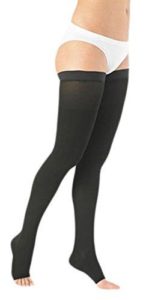 Thigh-high stockings can be worn one at a time and come up to the highest part of your thigh, typically just below your undergarments. They can be worn on either leg interchangeably, meaning there is no designated “left” or “right.” The interior of the thigh-high has a synthetic band, typically a rubber or silicone type of material that helps grip the thigh skin so it does not roll down or bunch up.
Thigh-high stockings can be worn one at a time and come up to the highest part of your thigh, typically just below your undergarments. They can be worn on either leg interchangeably, meaning there is no designated “left” or “right.” The interior of the thigh-high has a synthetic band, typically a rubber or silicone type of material that helps grip the thigh skin so it does not roll down or bunch up.
Open-toe style means that the foot portion of the stocking stops at or above the base of the toes. This style allows for flip-flops and open toe shoes to be worn. The open-toe option allows for some inventive tricks for getting the compression hose on, such as “slippies” (Link to slippy).
 “Slippies” are extremely helpful tools. They look like socks but are typically made of a slippery fabric or special rip-proof paper. Slippies work by allowing you to get the stocking onto your foot and over your heel bone more easily. Once your foot is in the stocking, the “slippy” is pulled through the open-toe of the stocking and removed.
“Slippies” are extremely helpful tools. They look like socks but are typically made of a slippery fabric or special rip-proof paper. Slippies work by allowing you to get the stocking onto your foot and over your heel bone more easily. Once your foot is in the stocking, the “slippy” is pulled through the open-toe of the stocking and removed.
Certain brands of compression hose provide these ingenious slippies in the box if you buy the open-toe type from them. These brands include Juzo®, Jobst®, and Medi® to name a few.
Closed-toe thigh highs
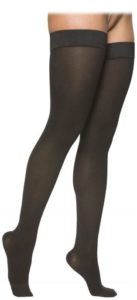 These are self-explanatory and the same as their open-toe counterparts with the obvious exception of the foot being completely enclosed which some patients prefer.
These are self-explanatory and the same as their open-toe counterparts with the obvious exception of the foot being completely enclosed which some patients prefer.
Closed-toe styles may be less expensive than open-toe for some manufacturers. However, we generally find that open-toe stockings are usually preferred by our patients for the reasons listed above. Closed-toe styles are certainly more challenging to apply.
Pantyhose
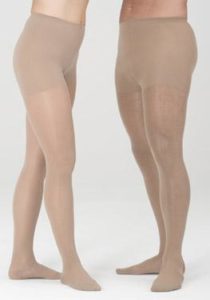 These cover both legs and come up to the waist. They are offered in open-toe and closed-toe varieties depending on the manufacturer. Some patients prefer pantyhose, typically female patients who are more accustomed to wearing hosiery. Those who favor pantyhose argue that they are more comfortable to wear on a daily basis and serve as a type of shapewear. However, for others, the pantyhose are not as practical.
These cover both legs and come up to the waist. They are offered in open-toe and closed-toe varieties depending on the manufacturer. Some patients prefer pantyhose, typically female patients who are more accustomed to wearing hosiery. Those who favor pantyhose argue that they are more comfortable to wear on a daily basis and serve as a type of shapewear. However, for others, the pantyhose are not as practical.
Thigh-high with hip attachment
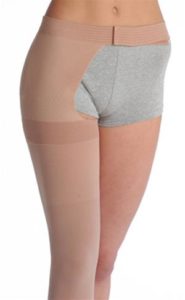 These are the same the thigh highs stockings previously described. These too come in open and closed-toe varieties. However, the difference is that they come with an attachment for the waist that prevents the thigh high from rolling down the thigh. Fuller figured patients often prefer these, as do those who have sensitivity to the silicone band of traditional thigh highs.
These are the same the thigh highs stockings previously described. These too come in open and closed-toe varieties. However, the difference is that they come with an attachment for the waist that prevents the thigh high from rolling down the thigh. Fuller figured patients often prefer these, as do those who have sensitivity to the silicone band of traditional thigh highs.
Custom stockings
Typically, though you are measured by our office or by the durable medical equipment supplier (“D.M.E.”), most compression hose are considered “ready to wear.” They come in standard, off-the-rack sizes based on the circumference measurements of your ankles, calf, and mid- thigh. Your height and, most importantly, leg length, are taken into consideration as well.
Custom hosiery is just that – they are custom made for you which requires much more timely and thorough measuring. These stockings are more expensive and are often excluded by many health insurance companies. We provide the option of custom stockings only when necessary.
Knee highs
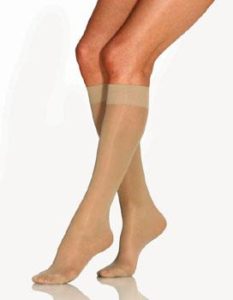 This style of stocking comes to below your knee cap. Knee highs also come in open and closed-toe. Although patients often prefer these over thigh-highs or pantyhose, knee highs are not always appropriate after vein surgeries. However, for regular everyday wear, for flights and considerable car travel, knee-highs may suffice. Additionally, there are times when Dr. Krysinski will permit knee highs postoperatively.
This style of stocking comes to below your knee cap. Knee highs also come in open and closed-toe. Although patients often prefer these over thigh-highs or pantyhose, knee highs are not always appropriate after vein surgeries. However, for regular everyday wear, for flights and considerable car travel, knee-highs may suffice. Additionally, there are times when Dr. Krysinski will permit knee highs postoperatively.
As you have now learned, compression hose aren’t just available in one flavor. When Vein Institute of PittsburghSM prescribes you compression stockings, we will provide you with several options. The flavor you choose is up to you. Call now to schedule an appointment or if you have any questions. Our phone number is 724-934-8346.
